#hire 2d animation company
Explore tagged Tumblr posts
Text
This is my formal plea to literally everyone that you STOP going out and buying tickets to Disney remakes and sequels. As someone who holds that studio very close to my heart for the magic they used to create, it genuinely blows my mind how they're still finding immense financial success with shitty reincarnations of their preexisting IP. Do people not understand? Hate alone will do nothing! The top people at Disney are suffocating their artists with corporate greed! The executives and the shareholders do not give a SHIT if people on letterboxd hate their movie. If it's making money in the box office, they will continue making garbage because it WORKS! Please get a fucking grip and support other animation studios or literally any new IP that Disney actually decides to take a chance on, because money speaks, and it's the only language these current money hungry cowards at Disney seem to understand! I know for a damn FACT Walt has been turning in his grave for the past ten to fifteen years and it makes the prior Disney obsessed child in me SICK!!!
#disney#moana 2#snow white remake#literally fuck this shit I hate this greedy ass company so damn much#firing their fucking 2d animation team bc they're unionized#hiring diverse cast just for the tokenization and then leaving them to deal with the backlash#leaving artistic decisions until the last fucking moment and changing things at the flip of a coin when shit gets rocky#i would actually rather pull out my own nail than watch the new snow white movie#I know it makes me sound insane#but there is something so innately evil about taking the most classic film in your company's history and bastardizing it#everything about it looks shit#the casting for the evil queen is awful the cgi looks shit the costuming is an eyesore the girlboss storyline is going to being grating#like genuinely I love the original snow white so deeply just as a work of art it is such a beautiful and important movie in cinema#and it's the last one I thought they would dare mess with and here we are#like just actually fuck them. luigi if you need another name...bob iger might be an option...#that is a joke please don't put me on a watchlist fbi#but seriously like go watch something else literally anything else#starve them of their precious profits until they make some good shit again#until they let creativity flourish like Walt once did#go watch the wild robot or something of that nature if u need a good animated film#disney is not the animation powerhouse anymore i fear
14 notes
·
View notes
Text
i think cg that tries to look like 2d should be reserved for independent animators, video games and people who actually do something interesting with it rather than copping out for an animated series or film. if this were a game itd fit but it isnt. so now this just looks cheap to me
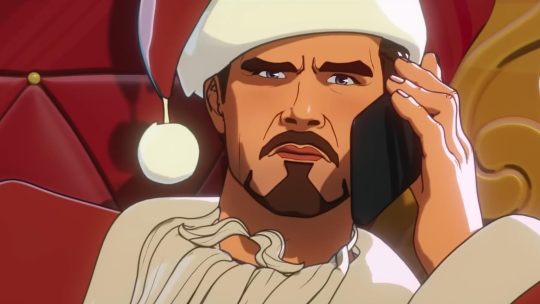
#not art#all art may be good art but companies refusing to hire 2d animators drives me crazy#(especially considering the fact that for a while 2d animation was my main “art thing”)
1 note
·
View note
Text
I fucking hate this. They butchered his animations so badly.
In contrast, I remember seeing a few DTVA ads where multiple characters from different shows appeared and they would either perfectly replicate everybody's art styles, or got the original animators back on the scene for those short 40-second ads. They weren't good ads mind you, but at least when it came to the animated characters, they made sure to get the animation right.
Or maybe I'm just delusional and entitled and I'm remembering things wrong. :/
Another recent Wander Over Yonder cameo from the DTVA animated parody of High School Musical's "Born to be Brave"
#I still despise Wander and the bird dude's animations here because they look so wrong and janky#Like. This is DISNEY. You know. The guys who commercialized 2D animation? The guys who made movies like The Lion King and Tarzan#And that one movie with the Genie (I forget what it's called IM SORRY) and Mulan and Snow White#aka THE GUYS WHO KNOW WHAT THEY SHOULD KNOW WHEN IT COMES TO ANIMATION???????#Disney is a billion-dollar company and yet they show children shit like this. I haven't even seen the DuckTales reboot aside from a few cli#and yet even I know that the pilot guys animation is wrong#I feel violated for such a petty reason I'm so so sorry#I'll get over it. Duh. Course I will. This is a tiny little inconvinience.#But it still pains me to see Disney animate one of their best MC's like this. As if this parody is being animated by newbies.#If it was animated by someone new in the industry I will quickly retract my statement because that would just be mean#But if that were the case then why hire someone completely new to animate this parody??? Again. THIS IS DISNEY.#okay rant over sorry for making you go through the tags for that one anywhizzle#tumbleweed#blog/ask stuff
221 notes
·
View notes
Text
Okay so saw the trailer for Season 5 of LMK and the discord that is happening. So I did a little research and here’s some information all LMK fans should be aware of. (EDIT: new information has come forth)
Link (One of the people who worked on Monkie Kid at FlyingBark has now made a statement, I’ve rebloged the tweet for anyone who may not have access to twitter)
Looks like it’s official that Flying Bark will no longer be working on LMK.
https://issuu.com/brunico-issuu/docs/kidscreen_febmar23_lowres/s/18007818 (<- Link to article)
It looks like LEGO has given WildBrain studios the license to LMK for the next 2 seasons plus a Special.
(It has been shown to me, that I have mis interpreted the information in the Kidscreen article and I apologize for that. I was trying to find some string of answers and jumped onto the first thread of evidence I could find.
What does remain true is WildBrains credentials and to please not point your annoyance, frustration, and disappointment onto either of the animation studios, or their staff, if your goal is for better animation your best corse of action is still to push LEGO company about it)
Now first off I want to say that The Vancouver studio they are talking about is pretty good, they used to be DHX and the part of DHX that did My Little Pony: Friendship is Magic, along with Carmen Sandiego, so they do know how to animate 2D pretty well but it’s all rigged 2D either done through Flash or Harmony, so doubtful we will get the kind of battle animation we got from Barks studios.
PLEASE don’t stop supporting or watching LMK that’s not going to help, it’s probably already set in stone that WildBrain will have LMK for the at least the next 2 seasons plus special, also don’t attack WildBrain that’s like complaining to a cashier about how a store is run don’t do that. Also don’t go after the show runners(ie: writers); they are the cashier supervisors; When it comes to massive properties like LEGO, they have no control over who the company hires to be cashiers.
If you're going to complain to anyone, complain to LEGO company, (the part that has control over shows, not the one that has control over lego sets). Now don’t say things like “if you keep this studio I’m gonna stop watching Monkie Kid and buying your merch” don’t do this it will only cause LEGO to drop the show, if a show doesn’t have the view numbers or the merch numbers, they’ll drop the show regardless of the praise or complains about said show.
Question Lego about their choices, request Lego for animation the same quality as the previous season, question lego how to get flybark’s animation back.(new info has come in, please read link to twitter statement or the reblog of the twitter statement)
Please reblog this, or screen shot and repost what I am saying; this is the one case where I give permission. I know a lot of fans are spinning (Me included) right now and I don’t want anyone to take out their annoyance, frustration and disappointment on the wrong people.
#lego monkie kid#lmk#monkie kid#season 5#monkie kid season 5#lego monkie kid season 5#lmk s5#lego monkie kid s5#animation
281 notes
·
View notes
Text
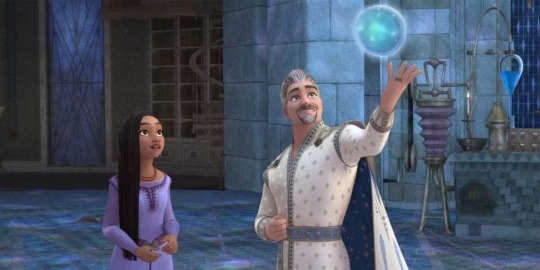
It's funny how WISH was criticized for having "bad animation." The claims made by faux critics is that it's copying Spider-verse.
Anyone who's actually known about animation other than being a "fan" knows that Spider-verse does not own the "hybrid 3D-2D" style. Hell, The Last Wish was literally praised for "imitating it."
This is interesting because in the late 2000's, Disney had originally made Tangled, back then as "Rapunzel Unbraided" to look like a moving painting.
youtube
They scrapped this idea because they don't have the technology for a software at the time, but still kept the hand drawn vibes on the character design.
Heck, Disney even made short films to test if they can make a full film in this hybrid style. WISH just happens to be the perfect film for them to make a full feature in this style of animation.
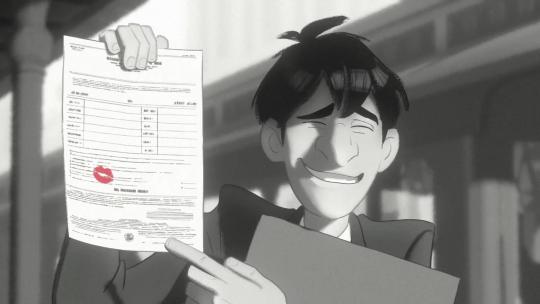
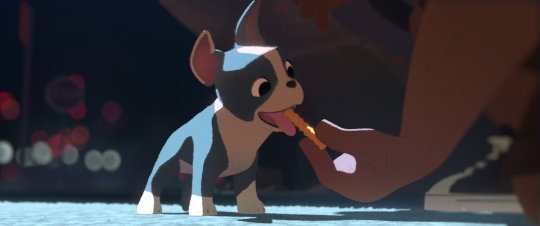
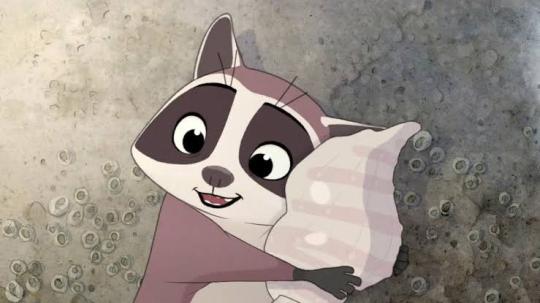
They even use the style in some of their movies in brief scenes like in Raya and Strange World.
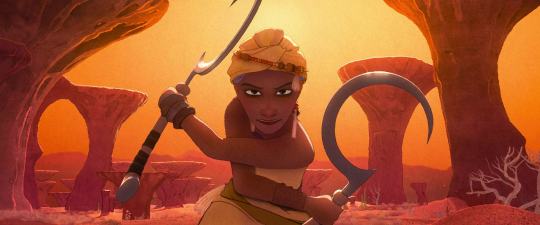
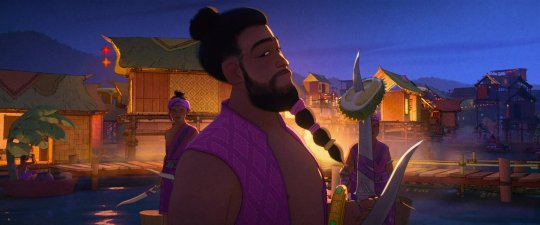
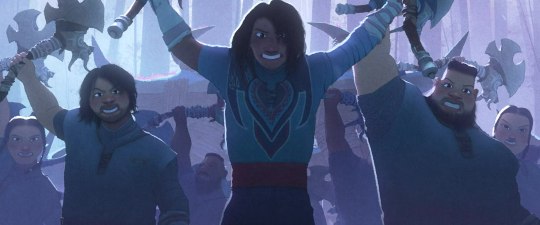
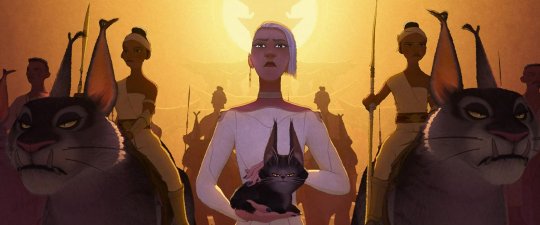
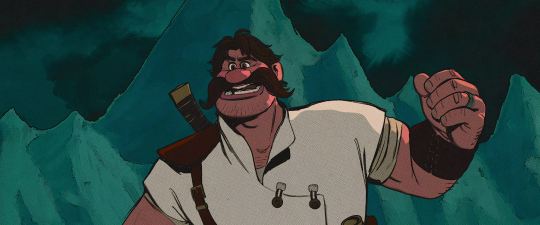
Other criticisms about WISH's animation that it looks like Sofia the First or that it's colorless are just goat crap complaints mostly because "it's different".
The "rumor" that WISH was originally going to be animated in 2D is just false. Disney had numerous made statements that most of their newer original films were intended to be animated in hand drawn, but don't have the time and budget to do so. "Oh, they're a billion dollar company, why can't they just hire hand drawn animators?" Simple reason, either they are retired, working on other projects, teaching at art schools or are still working at Disney, doing character animation for the 3D artists to follow. So, making a film purely for the sake of "bringing back 2D animation" is not worth getting these animators back.
2D animation was DYING during the 2000's. The reason why Princess and the Frog failed to bring 2D animation back was because of its writing, being released alongside Live Action Pocahontas Blue Edition, and that its mostly tied to the Disney staples that were criticized at the time.
Even if WISH was 2D animated, people will still criticize it. Which just shows that the animation alone, regardless of style cannot carry a movie.
Dismissing a work and calling it A.I garbage all because you hate the company behind it is just apathetically insulting the artists and animators who are just doing their job. A job that they are at risk losing to the things you are comparing them to.
#disney wish#wish 2023#wish movie#wish#paperman#raya and the last dragon#tangled#rapunzel unbraided#strange world#Youtube
65 notes
·
View notes
Note
On the topic of game reception, what are your thoughts on the current state of pokemon?
OK THIS ASK WAS SENT BEFORE THE HUGE LEAK LOL but I have a lot to say:
I watched VHS tapes, played the games, and owned merch since a young age so the series is very special to me. But I don't like the current direction at all and it's not because of the designs or nostalgia. The quality and game performance plummeted so how can I enjoy playing when there's mad lag or low frame rate that hinders my progress and worsen the experience??
It took too many years for them to realize they need to put quality over quantity after the SWSH mess, seeing that they can get away with pretty much ANYTHING and still make huge profit. You see people say that Pokemon should've never went 3D and stay 2D but tbh, it's a series that improves it's graphics as technology advances so it's not a surprise for them to finally go 3D and personally I think that's fine but just keep it looking good and fun (though I would love a 2D/3D hybrid). XY introduced a lot of new features but still lacked in some aspects that still haven't really been solved or added.
Reusing assets is common in the industry but only to a certain extent. They claimed that SWSH was taking a while to make because they were making brand new models which turned out to be a lie and they look like bootleg figures with the new lighting. The 3DS models were ripped from Pokepark, including some animations, but a lot of them still barely have any character. They have their own in-house team (Creatures Inc) so they made the decision NOT to have pokemon properly animated or look alive.... Also they made spin-offs like Ranger, Colosseum, Pokepark, and Pokken which look AMAZING
FRLG took only one year while HGSS was being developed at the same time as Platinum and took 3 years to finish that turned into one of the best games and remakes ever made. As the franchise expands, the team also needs to add more manpower but Game Freak can definitely afford to get more resources to help them?? They can't continue having a ragtag team of like 20 people to make a game back then and do the same now then expect good results... Hire more people who know how create with current gen consoles IT'S COMMON SENSE PLS also I can't believe they had a different company create BDSP knowing how beloved and groundbreaking DPPT was?? No redesigns like the previous remakes and thought it was a good idea to keep it looking a carbon copy to the DS style...
Also it's shocking to see how fan reception can change how the devs direct the next gen ESPECIALLY when it's not even real constructive criticism?? When Unova came out, I remember seeing all the online outcry about "OH THEY HAVE AN ICE CREAM CONE POKEMON AND A TRASH BAG, THEY'RE RUNNING OUT OF IDEAS EW" then actually hear it being repeated at school.... I WAS TRYING TO SURVIVE SINCE DAY 1 IN THE TRENCHES DEFENDING THIS GAME IT WAS ALWAYS GOOD AND DIDN'T NEED 10 YEARS TO AGE WELL. It's crazy how these are the same people who want another Kanto when Trubbish is Grimer (garbage waste) and Vanillite is Voltorb (based on literal items) then you could not catch any other pokemon from different regions in the main game. And the leak confirmed that the disgruntled hate from the west made the devs not release new pokemon in B2W2 and move them over to XY instead AND NOT GIVE A SINGLE GEN 5 MEGA EVOLUTION. So we were robbed because of genwunners who were fixated on the wrong things and ignored all the great content Unova brought us. It's strange how players keep complaining they want a different and fresh game, but want it to continue being super formulaic and binary like wtf do you want make up your mind
None of the switch titles really got me invested and I always end up replaying the older games but hopefully PLZA will break the curse and finally give us a nice game. Also why don't we have more spin-offs on the switch if there's so many of them floating around like the DS had a bunch??? STOP BEING COWARDS I WANT A POKEMON NINTENDOGS GAME OR THAT FIRE EMBLEM CROSSOVER WE WERE SUPPOSED TO GET. I JUST WANT TO HAVE FUN AGAIN ;w;
23 notes
·
View notes
Note
Out of curiosity, when/where did you first learn to animate? What inspires you to make your animations?
(I'm partly asking this because the urge to animate hit me like a truck once I really got into PMATGA, lmao. I've only ever made around 3-4 small ones over the span of several months)
Good question! Long answer! :'D
I've been dreaming of being an animator since I was young, because my elder sister studied animation and that's where I learned more about it. She gave me her copy of The Animator's Survival Kit from Richard Williams after she finished studying, and I've kept it with me ever since. Mind you, I never finished it, because distractions happened XD But I've read the first bunch of pages and started getting a fletchling idea of how animation worked. This was when I was around 10-14 years old. My favourite movies were almost exclusively Disney or Dreamworks classics, and my love for them grew as I grew older. I keenly observed their animations and analyzed what it was that them so appealing, long before I actually learned how to animate properly. Through observing what made those animations so appealing and life-like, I've built up references in my mind as a benchmark as to how animation is supposed to look. So when the time came to learn animation properly, I've already had a headstart thanks to observation, which sped up my learning quite a bit.
Now, let me tell you about a man named Aaron Blaise.
youtube
To say that Aaron Blaise is an animation legend would be an understatement.
He was the co-director of Brother Bear. He worked on various Disney movies that shaped our childhoods. He animated young Nala from The Lion King, Raja from Aladdin, and he also worked on Beauty and the Beast, Mulan, Pocahontas, and the Rescuers Down Under. He left Disney in 2007, but in 2012 he teamed up with a friend and decided to start CreatureArtTeacher, a website where he shares everything that he's learned, whether that be animation from his time at Disney or just art in general. He brings aboard many other professionals in the same field and beyond, where courses are offered at the most affordable prices. Often, he'll also offer lessons on various art subjects on his YouTube for free, and he livestreams frequently!
It's thanks to these lessons that I've learned more about animation. While I didn't practice often, I did start taking my first steps into doing animation, spurred on by inspiration from Aaron's videos. This was around age 16-18. Unfortunately, I can't track down my first ever animation I've made. But I did make this sometime before turning 20;
Yes, that's a BG shot from pmatga XD
So going into my twenties, I knew enough about animation to make small little snippets such as the one above, but I wasn't yet at the point where I'd consider myself an educated animator. And here's the thing; when I went to university, I studied Visual Communication & Design, which mostly focused on graphic design. In that course, we did do a little bit of animation, but it was nothing I've already known, and it was mostly cut-out animation where you control it like a puppet in After Effects. What I really wanted to do was dive deeper into traditional 2D cell animation, but we had to preferably work in 2D cut-out animation to save time. It was a cool learning experience, but also a bit frustrating because I prefer the traditional frame-by-frame method. Alas, that would take too long, and my uni projects ran on a 2-week basis (a new project every two weeks), so I couldn't push to improve my animation skills in the direction that I wanted to. I still learned quite a bit tho, and got valuable experience with different programs, so I guess the time I got a taste of animation education was around the age of 22.
But then came 2024, age 24, when I got hired as a storyboard artist at my current job. Thanks to the company's help in giving their workers the space to learn new things, I finally tackled animation in earnest. I brought out the good ol' The Animator's Survival Kit and Aaron Blaise's courses and taught myself as much as I could, along with the support and guidance of the studio. Needless to say, sometime afterwards I could make the Rubber Pac animation I did here.
So yeah! It was a combination of things. Both my sister's influence and the influence of animated movies from a young age, Aaron Blaise's courses, university, and real-time work experience are what taught me animation <3
As for what inspires my animations, it mostly comes down to music tbh. I can always conjure a scene in my head along with whatever music is playing. Other than that, it's the desire to give life to something in an intrinsically human way, especially as art. I've always felt closest to God as an artist 💙
Told ya it was a long answer xD But hey, twas a fun answer! >:D
21 notes
·
View notes
Text
I'm not super into Lackadaisy, but I am super into animation, and...
How are they planning to finance an entire season with just 1,000,000?
(Everything below assumes that they're aiming for episodes that are comparable to the pilot & that they plan on fully financing the season with solely the donations on Backerkit. It's likely they have additional financing through merchandising, the pilot, and/or Iron Circus's other projects, but since that information is not available, I'll go off of what I know. Additionally, production management and budgeting are extremely project dependent, so the "averages" listed below may be far off what the PM on Lackadaisy's got quoted.)
[EDIT: It’s been brought to my attention that the episodes are 10-12 minutes long, which means it’s MUCH more doable than I was expecting! They budgeted for a lean (but doable!!!) production. Thank you to those who clarified! I’ll leave this post as-is for those interested, but read it knowing they’re considering roughly half the time I used to calculate everything below!]
Quick preface as to why I wanted to talk about this and Why I Feel I May Have Valuable Things To Say: I'm an indie filmmaker and professor of animation, production management, and VFX. I'm not trying to call out the company or the production because-- and I cannot say this enough-- I truly do not know what's happening on the back end. Every production is wildly different. Their original goal was 125,000, with 45% going to animation-- that includes rough, cleanup, & color. That means that for a ~27 minute animated episode, they've got $56,250. If we collect all facets of production together-- story, layout, animation, compositing, and editing-- we wind up with a grand total of $82,500. Even if we estimate at the lowest average production cost of $8,000 a minute, this budget would account for ~11 minutes of animation.
An animator's average hourly rate is ~$36. With the outlined budget, the Lackadaisy production would be able to afford ~1562 hours of animator manpower. Let's assume (for the sake of this discussion) they'll split that over at least four animators, leaving us with about 10 weeks of full-time work (~390 hrs per person) for four people.
Now this may seem like a lot of time, but as far as I can tell, the pilot was largely animated frame-by-frame without the use of 2D rigging. This means every frame needs to go through roughs, then cleanup, then color, then composite. Every frame you see on-screen has been worked over at least four times-- six if you count layout and story. Ten weeks is simply not enough time to finish 27 minutes of 2D animation.
Now, I know what you might be thinking; Artsekey, they never said their production period was ten weeks! And you're right! However, that's how much production time they can afford. Whether it's split over 20 weeks or a year, they only have enough money to pay their animators for 1562 hours of labor.... if they're paying them a competitive hourly wage. To be completely clear, I am not insinuating that they're low-balling their animators; there're a dozen unknown factors that play into this, such as:
The level of animator they're hiring (an apprentice animator may make ~$17-$23 an hour whereas an experienced pro may make ~$43-$45.)
Whether they're actually hiring animators as opposed to contracting animators (I assume their model is likely relying on the latter based on the fact that I'm seeing a lot of animators that worked on 1-3 shots). They may be doing single-sum deliverable based contracts rather than hourly.
The use of tools like EBsynth (which is listed among the programs they're using) and smart frame management (which they're definitely doing!). This can, if used properly, cut down on the number of in-betweens animators need to get done.
The amount of money the studio is planning to re-invest on their end. The goal on backerkit may just account for the additional funds the studio needs to enter production, meaning their budget may be far larger than what's listed. However, if this were the case, I'd hope they'd disclose it! If I were considering backing the project, knowing that the studio was going to be buying in would increase my faith in the fundraiser.
Obviously, the team loves animation. It shows through in the pilot, and I think that it's clear in their mission statement that they stand against the exploitation of animators. But... I also know that indie production is like trying to wring water out of a log. I'd personally like a more comprehensive breakdown of their expenditures not because I think there's anything suspicious happening behind the scenes, but because as someone who teaches production management for animation and who has an interest in indie production specifically, I'm wondering what choices they're making to stretch their funds.
And what about sound?
While I'm not an expert in audio design, I do live with a professional voice actress/audio engineer, and she had a few thoughts I'd like to share.
At their original goal, roughly ~12500 was set aside for:
Sound Design
Music Composition
Voice Acting
Now, I can only refer to my own experiences as an indie filmmaker regarding price, but the rate I received-- from friends-- for sound design was roughly ~325 per minute, and this was a very, very good deal for what I personally needed. The audio engineer can be responsible for collecting and/or recording foley, or the sound effects you hear in film. This can be expensive and time consuming. They're also responsible for editing all the foley, music, and voice acting together in a way that feels seamless. If we were going off the rate I was given (which was very reasonable given the amount of work that needed to be done), ~27 minutes of full foley, complex sound design, and mixing would run about ~8,000. This number could fluctuate significantly depending on whether they need the sound designers to create the foley, get some ADR in, or just mix the audio, but let's assume that Lackadaisy has a pre-existing foley library and that the price falls in a lower range of ~5,000.
Music's a complete wild-card. In my experience, most composers charge per-minute, and most of the indie composers I've worked with were at a rate of ~$100 per minute of music. That'll land at a nice $2,700.
Now where my friend got particularly heated was the rate for the voice actors. As a voice actress herself, she was floored that the budget for voice was so low-- particularly because the project's pilot pulled industry voices like ProZD. Obviously, the price for voice can vary wildly based on how many lines an actor has, their experience as a voice actor, their personal terms, ect. The cast for the pilot included 11 credited actors. I can't assume their rates or whether they charge a fee to even get in the booth (my roomate charges $100 flat at the start of a session), but if my other estimates are in the right ballpark, their goal budget accounts for roughly ~500 per VA (and it's extremely unlikely that it's divided equally for obvious (and logical) reasons). Honestly, for a full episode of animation, that's... about average. But average in the voice-acting community doesn't necessarily mean good. Voice actors are notoriously underpaid, and-- as previously mentioned-- bigger names with more lines are going to be taking in more of that pay-pool.
And, of course, the Production Managers.
I'm not going to speak on this for too long, but the original budget held 8750 for the admin team. I assume admin includes their PMs, director, and leads (if they have enough specialization to need leads). Assuming it's just one PM and one director, they're pulling in ~4375 a person. For the duration of the project. There's no way that prepro, production, and post would take less than 8 months. Of everyone involved in a production, these roles are on-board from start to end, and it's simply not enough! PM's are absolutely critical to success!
Not to mention the editor!
In animation, the editor is the director's right-hand man, and is working to edit the storyboards, reels, scratch music, and the final cut. This role is also on the production from pre-to-post, and their original budget allows for.... $2,500. What? If I go extremely low on the hourly for the editor, you maybe get one part-time weeks' worth of work for several edits of a 27 minute episode. With most everything else I've talked about, I've mentioned there's a lot of wiggle room because of all the factors I simply don't know, but in no universe is $2,500 enough for this editing job. (Even at the current budget of 1,000,000, $4,000 an episode is super low.)
But, hey! They've got more money now!
Of course, all of these concerns go out the window when you consider that the team's already raised a whopping $953,000 (as of 7/31/23) with the fundraiser only up for five days... right?
Well... It certainly alleviates some of the strain, but their stretch goals were scope increases! This means that once they reach their 1,000,000 stretch goal, they're adding on four additional ~27 minute episodes. This increases the budget-per-episode to 200,000 (yay!), but that still leaves the project with about $7,400 to spend per-minute... which, in the world of animation, isn't much!
All in all, I think that the original goal of 125,000 -- if there was going to be minimal investment from the company-- was completely insufficient, and it would have been irresponsible to try to produce a 27 minute long pilot with that budget. At the same time, I imagine the PM/Admin team could reasonably expect a strong outpouring of support from the fans based on past success and low-balled the original goal. Now that they're near 1,000,000, I think- and hope - they'll be able to swing it.
If anyone has any insight into the production of the pilot (either because you worked on it or know someone who does), please feel free to add context to this post! Again, I am not trying to call out Iron Circus. I'm fascinated by indie production and have been following the successes and failures of crowdfunded animation since it started picking up, and while the goal for Lackadaisy raised some concerns for me up-front, I think they're making strategic choices based on hard data (that we the public are not privvy to). They've already done it once, so they should be able to do it again!
108 notes
·
View notes
Text
Monolith Soft 1st Production team hiring for new RPG directed by Tetsuya Takahashi - Gematsu

Monolith Soft‘s 1st Production team, the studio behind the Xenoblade Chronicles series, is hiring for a new RPG directed by Tetsuya Takahashi, the company announced.
In a message on the hiring website, Takahashi said that while he could not go into further details, the new RPG is taking on more new challenges compared to previous Monolith Soft titles.
Open positions for the new RPG include a 2D artwork staff designer, 3D CG character designer, 3D CG map designer, development environment engineer, field level designer, assistant director, in-game animator, and an effects designer.
7 notes
·
View notes
Text
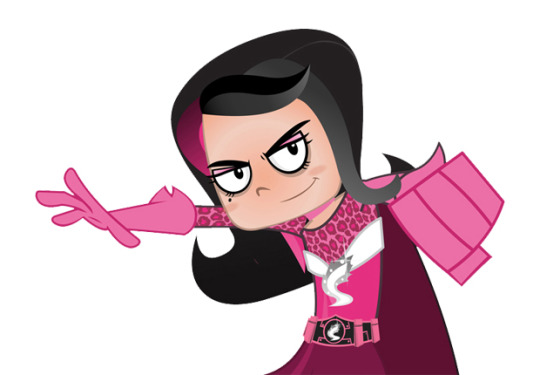
Rising Stars of Animation
By Ramin Zahed
September 14, 2013
2013’s crop of up-and-coming animators proves there’s still room for originality and inventiveness in the toon landscape.
Obie Scott Wade
Creator, SheZow! (Hub Network); CEO, ObieCo Ent.
The announcement earlier this year that Hub Network had taken on a new 2D animated series about a boy who discovers a superpower-endowing ring–with the catch that the ring is meant for a girl and grants him a feminine evil-fighting outfit–caused quite a stir with conservative bloggers and raised questions about whether it was “kid appropriate.” Luckily, Hub poo-pooed the haters, and Obie Scott Wade’s creative twist on the superhero genre, SheZow!, has been on the air in the States since June.
Wade, who bears no relation to Obi-Wan Kenobi but still may be a Jedi, says he was fortunate enough to learn the animation trade on the job.
“I first began drawing when I was three years old, and my artwork still looks like that, so I don’t draw,” he jokes (SheZow! is designed by Australian artist Kyla May).
As a writer, Wade learned the artform at the elbows of May, Anna Chambers, Paul Frank, Wayne Harris, Paul Tippet and Mike Moon.
The creator, whose previous credits include Disney’s Deer Mike, Turner’s Al Roach: Private Insectigator and Warner Bros.’ Baby Looney Tunes, was inspired to pursue animation by the work of Chuck Jones and Hanna-Barbera, and by the freedom of Internet distribution, co-creating the webseries Julius & Friends with a talented production team honing their craft as they went. His big break came when he was developing a concept for WBA–the show didn’t get made, but the process opened a lot of doors and created many key friendships in Toon Town.
Wade says he came up for the idea for SheZow! when he was just 10 years old:
“One Saturday morning, I wondered, ‘What would happen if I had found the amulet belonging to Isis and put it on? Would it work on me, a boy?’ I also wondered what would happen if Captain Marvel accidentally said she-zam instead of sha-zam. Would he get a girl’s outfit? If so, would he care? Would you?”
He says the biggest challenge of creating the show is having all the production outside the U.S. (in Canada and Australia). But seeing the final product and how kids react to it is always worth it.
The writer��who is also working on a kids’ book and is being tapped by Disney for a new toon—proves that sometimes, young creatives just need to let their natural selves shine through:
“Years ago, when I first got into the business, I called a TV production company looking for a job. The nice man on the phone told me that there was no work to be had because everyone was on hiatus. When I innocently asked him if ‘hiatus’ was an island, he laughed and hired me to write comedy.”
4 notes
·
View notes
Note
What do you think of Jeffrey Katzenberg and Michael Eisner?
Oh these two don't get me started on the drama they caused during the '80s, 90s amd 2000s at Disney, they are both pieces of work that have more cons than Pro
At least with Walt Disney or any of them they have shit that balances out the bad these guys they were just flat out me me me,
You know why DreamWorks was founded? because Jeffrey over here kept bragging about a job that he was going to have after the fact his so-called friend who had had the job before died in a helicopter crash!
It wasn't even a week later this asshole was walking around bragging about how he was going to get the job when they told him no and in fact fired him that's when he went and founded DreamWorks,
He also told animators to edit out scenes in the '80s when everything was still hand drawn, you couldn't edit out scenes. He was so obstinate on this that they had to get Eisner to stop him from destroying the film because he wouldn't listen to the animators behind it -.-
Also, blame Jeffrey for the reason why we do not have 2D animation in Disney anymore he tossed it out the window, and I quote because there is no money in it.
Jeffrey is definitely on my shit list I want to respect him but how can I respect him when he won't even listen to animators when they try to tell him you can't do certain things.
Eisner was a train wreck of a CEO did you know crime at the parks literally spiked, a kid was shot and killed in the Disneyland parking lot because of gang activity because of all the clubs he had added to the parks for teenagers and yes adults if you went to what they called Pleasure Island yes they had a land called Pleasure Island, it even had a lingerie store themed after Jessica Rabbit and Jessica Rabbit was actually the one sitting on the archway to the island,
I will say the majority of teens have good memories about one specific club called Videoopolis. However, the rest of the clubs were known for being well, not so good,
Team members of gangs would go to these clubs and hire kids out of them this went on for years,
He renamed the Zippity Doo Dah ride to Splash Mountain not because they were retheming it to actually fit the H2O splash mermaid movie. No, he just renamed it because he wanted to,
If anybody got a swift kick in the ass from Mickey Mouse, it would be Eisner. He about bankrupted the company a few times because originally no Hong Kong and Paris were absolutely bleeding money when they were initially built because they went so badly over budget because of Eisner!
He was a stubborn hard ass of a man who if anybody told him no he would throw a temper tantrum and figure out how to make it work anyways,
But the worst of the worst I will bring his name in is still chapek somehow chapek has beaten Eisner for being the worst CEO so Eisner isn't my most I do not like you on my list of Disney staffers but he's damn near close.
11 notes
·
View notes
Text
Generative AI can most capably produce 2D images that managers in cost-squeezed studios might consider “good enough,” a term AI-watching creative workers now use as shorthand for the kind of AI output that’s not a threat to replacing great art, but is a threat to their livelihoods. Some clients care more about cost than quality, after all. Tasks like 3D animation and programming are, for now at least, much harder to automate in full. Games have, to varying degrees, used automation for years. They rely heavily on “AI��� programs that control enemies, environments, and nonplayer characters. That’s not what people are talking about when they discuss AI now. In 2024, they’re typically talking about generative AI produced by large language models (LLMs), and the related systems that have been unleashed by the latest boom. A recent report from the consulting firm CVL Economics, commissioned by entertainment industry trade groups, found the gaming industry already relegated tasks to generative AI more than its peers in TV, film, or music. According to its survey of 300 CEOs, executives, and managers, nearly 90 percent of video game companies had already implemented generative AI programs. Gaming, CVL found, “relies heavily, more so than the other entertainment industries, on GenAI to carry out tasks like generating storyboards, character designs, renders, and animations. In fact, by some estimates GenAI may contribute to more than half of the game development process in the next five to 10 years.”
Support indie developers and studios who value their employees. Game developers are paid while they are developing games; once a game is released, all profits go to the studios, who often lay off swaths of employees hired for only specific projects. Boycotting games affects companies and executives, first and foremost, and NOT devs. They'll pay attention to where the money goes.
3 notes
·
View notes
Text
Dedicated to the memory of Britt Allcroft, developer of the Thomas & Friends series, who passed away on December 25, 2024. Rest in peace…
Obscure Animation Subject #182: Cosgrove Thomas
Remember Thomas & Friends? It is British children’s television series based on the Railway series books by Rev. W. Awdry, which was developed by the now late Britt Allcroft, and lasted for 24 seasons of 584 episodes from October 9, 1984 to January 20, 2021. We all grew up with it in some way with all the engines and stories it had to offer.
However, before we got the 1984 series, there was gonna be an animated musical series. There was another past attempt of being the Railway series to screens, back in 1953 via a live broadcast on BBC, which wasn’t well received. However, will be sticking with the cancelled animation that was slated for a 1976 release.
Andrew Lloyd Webber, a guy who had a passion for music and was a fan of the Railway series since childhood, wanted to do a musical television series adaptation and pitched it to Kaye & Ward, the publisher of the Railway series at the time. Being a composer, his previous talents includes musicals Joseph and the Amazing Technicolor Dreamcoat and Jesus Christ Superstar, and scores for the films Gumshoe and The Odessa File.
Webber had a number of meetings with the original creator Wilbert Awdry, and Stanley Pickard, Kaye & Ward's managing director. A song was also written by Peter Reeves to be used for the potential show. Awdry and Pickard agreed to give Lloyd Webber's company "control of almost everything-idea, the characters, every one of the twenty-six books, and even anything else not yet written on published." Development on the project has been going smoothly, but by November 1974, Wilbert was questioning about the production of the series, as the animation and filmmaking was paid from America. He quoted, "Once the Americans get hold of it, the whole series would be vulgarised and ruined." You know, this was a prediction that came true over 40 years later, and I will talk in depth about that series as it kinda relates to this canceled product.
A pilot was given the greenlit by Granada TV, and the team hired British animator Brian Cosgrove to direct the pilot. He would later become one of the founders of Cosgrove Hall Films along with Mark Hall. The animation used was 2D cutouts of the engines moving along a background similar to that of the Ivor the Engine series, something that might be covered in the future. The cutouts and backgrounds would be based upon illustrations from The Railway Series, with a Cosgrove touch.
The pilot was completed by 1977 and was shown to the executives. Granada declined to greenlit the series, as they thought that the Railway series wouldn’t be popular internationally. Years later they were proven wrong, but otherwise it was cancelled.
In spite of the pilot being dropped, Webber continued to show his love for the Railway series by founding a company by the name of Really Useful Group, a name inspired by the phrase "Really Useful Engine." He also wrote the musical Starlight Express, which was inspired by The Railway Series in 1984, and is one of his most famous works.
Currently, the pilot isn’t available online and it’s unknown if footage of it still exists. The only known glimpse available is a photograph of director Brian Cosgrove animating the pilot. 10 episodes had also been planned if the series was greenlit, each being a half-hour long, likely with episodes containing multiple stories from the Railway series adapted.
Many years later, following the abrupt cancellation of the original series, All Engines Go, which served as a reboot of Thomas & Friends, was produced by Mattel Television, with animation provided by Canadian studio Nelvana. It was developed by Rick Suvalle and received backlash among the Thomas community for being unfaithful to the original source material. Mattel couldn’t handle the backlash and used a “made for kids” excuse to justify the criticisms, which didn’t work because it was reported the target audience of little kids even hated it. It shares some things in common with this pilot, both are animated in 2D and feature some musical elements. However, that pilot at least tried being faithful to the original source material when compared to All Engines Go. It doesn’t help either that the studio responsible for animating it, Nelvana, a once respected Canadian animation studio, has turned into a corrupt shell of its former self as the employees and animators at the studio had noticed a toxic work environment thanks to directors such as Campbell Bryer, Jason Groh, Adrian Thatcher and Mike Geiger treating the staff members like crap.
So yeah, there you have it for this failed pilot from the 70s that is currently lost media. Maybe at some point it will be found, but it is a shame because I had some interest in watching this pilot.
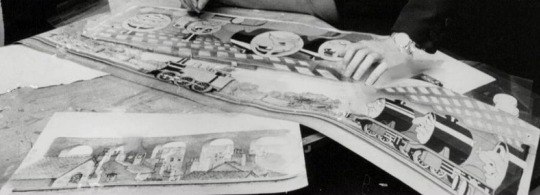
2 notes
·
View notes
Text
Wish (2023) Review
Potential spoilers ahead...
The writing, the animation, and even the color choices are nowhere near what one would expect from MULTI-BILLION DOLLAR company that is not only known for their animation, but a company widely considered to have revolutionized medium time and time again.
The writing is questionable at best, and at worst it, it feels like it was written by AI to some extent. Most of the dialogue feels rushed and incomplete. The questions with the writing really come to fruition when you look at the lyrics from the music, which, in musicals especially, is where the writing should shine and communicate the majority of emotion. The reason this movie doesn't succeed in this drastically important task could be for multiple reasons. One could be that the hiring of pop writers, who generally wouldn't feel the need to worry so much about making the lyrics carry any weight just so long as they are catchy songs. This led to less musical genre songs and more pop songs. Or… they used AI, which I feel is the more likely answer. I refuse to believe any human being would write the words "watch out world, here I are"(I'm A Star) and think it's good and acceptable under any circumstance, even when writing a pop song. Additionally, many of the scenes you'd expect to have any impact or relevance simply have no effect. For example, Asha at one point, fairly early on, wishes upon a star and the star comes to help her on her quest, but the star and whole idea of wishing on stars are practically irrelevant.
In terms of characterization, there isn't much to say due to the lack of establishing personalities and character arcs in general. Asha has little exposition, which isn't necessarily strange, it's actually fairly common in Disney Princess movies, but the lack of exposition coupled with the lack of believable motivation and growth results in a main character that is flat and a pure archetype with nothing unique. Every character in the movie lacks depth, development, and in most cases, personality. This makes it almost impossible for the audience to care about the conflict, the motive, and everything in between. This lack of development also makes it difficult for the audience to connect with anything or anyone within this story.
The Disney animation style is well-defined and well liked, however this movie's animation is just strange and feels un-mouse like. The animation ended up looking unfinished due to a lack of rendering and lighting. They tried to combine 3D and 2D animation which doesn't translate. As well as meshing the modern style with their classic animation style, despite the fact that these styles don't mesh the way they were trying to execute them.
The casting was really good. Which makes the mistakes, and questionable decisions, especially those in the writing, even more bitter because you know the cast is capable of delivering an amazing performance.
Many of the color palettes and choices were just simply unusual. The expected palette for example, is having Villains be associated with greens, purples, and blacks. This expectation was not only popularized but frequently attributed and associated with the company. And yet, they choose to disregard the precedent and history that they themselves fostered to put this movie's villain in white and gold, with the only sight of green being when ANY character does magic, while purple is Asha, the protagonist's, primary color. The color palettes may not bother everyone, but they are one example of where the choices made for this movie are weird and unexpected in negative ways.
The "message" that you have all the power to do anything you want, with no message of having hope, doing the right thing, or trusting someone/something to help you is done extremely poorly. Such a large company with such a successful history failing to even deliver this simplistic moral even a little is honestly sad. The plot of the movie makes little to no sense. There is almost no motivation for the audience to care about any of the characters, except possibly Asha, the main character. Many of the events throughout the movie feel disconnected and aimless. The entire movie feels like a series of "references" to other Disney movies, so blatant they should be called "callouts" instead, with few events pretending to be a plot between them.
In conclusion, this movie vastly under performs and fails to meet any of the standards expected of it. The only highlight i can think of would be Alan Tudyk's performance as the comedic relief goat. But even this character faces the same problems as the rest.
6 notes
·
View notes
Text

Robot Dreams (2023, Spain/France)
There exists an assumption that one has to be an animator in order to direct an animated film. While most cinephiles might reflexively point to Wes Anderson (2009’s Fantastic Mr. Fox, 2018’s Isle of Dogs), I think Isao Takahata (1988’s Grave of the Fireflies, 1991’s Only Yesterday) the exemplar here. Even so, a non-animator taking the reins of an animated movie is rare. Into that fold steps Pablo Berger, in this adaptation of Sara Varon’s graphic novel Robot Dreams. Moved after reading Varon’s work in 2010, Berger acquired Varon’s “carte blanche” permission to make a 2D animated adaptation however he saw fit. Like the graphic novel, Berger’s Robot Dreams is also dialogue-free.
Beginning production on Robot Dreams proved difficult. Berger originally teamed with Ireland’s Cartoon Saloon (2009’s The Secret of Kells, 2020’s Wolfwalkers) to make Robot Dreams, but these plans fell wayside when the COVID-19 pandemic hit. His schooling in how to make an animated film would come quickly. Despite an increased appetite for Spanish animation worldwide (2019’s Klaus, 2022’s Unicorn Wars), poor distribution and marketing of domestically-made animated movies has often meant Spanish animators have roved around Europe looking for work. With a pandemic sending those Spanish animators home, Berger and his Spanish and French producers set up “pop-up studios” in Madrid and Pamplona, purchased the infrastructure and space needed to make an animated feature, and recruited and hired animators. Berger’s admiration of animated film fuses the lessons of silent film acting (Berger made a gorgeous silent film in 2012’s Blancanieves; in interviews, Berger cites Charlie Chaplin’s movies as having the largest influence on Robot Dreams, alongside Takahata’s films) to result in one of the most emotionally honest films of the decade thus far – animated or otherwise.
Somewhere in Manhattan in the late 1980s in a world populated entirely of anthropomorphized animals, we find ourselves in Dog’s apartment. Dog, alone in this world, consuming yet another TV dinner, is channel surfing late one evening. He stumbles upon a commercial advertising a robot companion. Intrigued, he orders the robot companion and, with some difficulty, assembles Robot. The two become fast friends as they romp about New York City over a balmy summer, complete with walks around their neighborhood and Central Park, street food, trips to Coney Island, and roller blading along to the groovy tunes of Earth, Wind & Fire. At summer’s end, an accident sees the involuntary separation of Dog and Robot, endangering, for all that the viewer can assume, the most meaningful friendship in Dog’s life and Robot’s brief time of existence.
youtube
If you have not seen the film yet, let me address a popular perception early on in this piece. Set in a mostly-analog 1980s, Robot Dreams contains none of the agonizing over artificial intelligence or automatons in fashion in modern cinema. There is no commentary about how technology frays an individual’s connections to others. Robot is a rudimentary creation, closer to a sentient grade school science project than a Data or T-1000.
So what is Robot Dreams saying instead? Principally, it is about the loving bonds of friendship – how a friend can provide comfort and company, how they uplift the best parts of your very being. For Robot, the entirety of their life prior to the aforementioned accident (something that I, for non-viewers, am trying not to spoil as Robot Dreams’ emotional power is fully experienced if you know as little as possible) has been one of complete estival bliss. Robot, in due time, discovers that one of the most meaningful aspects of friendship is that such relationships will eventually conclude – a fundamental part of life. And for Dog, Robot’s entrance into his life allows him to realize that, yes, he can summon the courage to connect with his fellow animals, realizing his self-worth. Perhaps Dog gives up addressing the accident a little too easily, but the separation of friends has a way of complicating emotions and provoking peculiar reactions.
On occasion, Robot Dreams’ spirit reminds me of Charlie Chaplin’s silent feature film period (1921-1936) – in which Chaplin, at the height of his filmmaking prowess, most successfully wove together slapstick comedy and pathos. On paper, pathos and slapstick should not mix, but Chaplin was the master of combining the two. No wonder Berger fully acknowledges the influence of his favorite Chaplin work, City Lights (1931), here.
Across Robot Dreams, Berger inserts an absurd visual humor that works both because almost all of the characters are animals and despite the fact almost everyone is an animal. A busking octopus in the New York City subway? Check. The image of pigs playing on the beach while sunburnt to a blazing red? You bet. A dancing dream sequence where one of our lead characters finds himself in The Wizard of Oz performing Busby Berkeley-esque choreography on the Yellow Brick Road? Why not? Much of Chaplin’s silent film humor didn’t come from his Little Tramp character, but the silliness, ego, and/or absentmindedness of all those surrounding the Tramp. In City Lights, humor also came from the rough-and-tumble edges of urban America. Such is the case, too, in Robot Dreams, with its blemished, trash-strewn depiction of late ‘80s New York (credit must also go to the sound mix, as they perfectly capture how ambiently noisy a big city can be).
Amid all that comedy, Berger nails the balance between the pathos and the hilarity – pushing too far in either direction would easily undermine the other. The film’s melancholy shows up in ostensibly happy moments and places of recreation: a realization during a rooftop barbeque lunch, the emptiness of a shuttered Coney Island beach in the winter, and an afternoon of kiting in Central Park. It captures how our thoughts of erstwhile or involuntarily separated friends come to us innocuously, in places that stir memories that we might, in our present company, might not speak of aloud.
As the film’s third character, New York City (where Berger lived for a decade) is a global cultural capital, a citywide theater of dreams, a skyscraper-filled signature to the American Dream. To paraphrase Sinatra, if you can make it there, you can make it anywhere. But it tends to grind those dreams into dust. The city’s bureaucratic quagmire is lampooned here, as is its reputation for mean-spirited or jaded locals. Robot Dreams also depicts the visual and socioeconomic differences between the city’s boroughs. With such a jumble of folks of different life stations mashed together, Dog’s people-watching, er, animal-watching during his loneliest moments makes him feel the full intensity of his social isolation. With Robot, however, Dog has a naïve companion that he can show the best of the city to. Robot has no understanding of passive-aggressive or outright hostile behavior (see: Robot hilariously not understanding what a middle finger salute is – the only objectionable scene if you are considering showing this to younger viewers). Within this city of contradictions, Dog and Robot’s love is here to stay.
Though he is no animator, his experience in guiding Spanish actresses Ángela Molina, Maribel Verdú, and Macarena García in Blancanieves through a silent film was valuable. In animated film, there is a tendency towards overexaggerating emotions. But with Robot Dreams’ close adaptation of the graphic novel’s ligne claire style and the nature of Robot’s face, the typical level of exaggeration in animation could not fly in Robot Dreams. Berger and storyboard artist Maca Gil (2022’s My Father’s Dragon, the 2023 Peanuts special One-of-a-Kind Marcie) made few alterations to the storyboards, fully knowing how they wished to frame the film, and hoping to convey the film’s emotions with the facial subtlety seen in the graphic novel. Character designer Daniel Fernandez Casas (Klaus, 2024’s IF) accomplishes this with a minimum of lines to outline characters’ bodies and faces. Meanwhile, art director José Luis Ágreda (2018’s Buñuel in the Labyrinth of the Turtles) and animation director Benoît Féroumont (primarily a graphic novelist) visually translated Sara Varon’s graphic novel using flat colors and a lack of shading to convey background and character depth (one still needs shading, of course, to convey lights and darks of an interior or exterior).
Robot Dreams’ nomination for the Academy Award for Best Animated Feature this year was one of the most pleasant surprises of the 96th Academy Awards. In North America, Robot Dreams’ distributor, Neon, has pursued an inexplicable distribution and marketing strategy of not allowing the film a true theatrical release until months after the end of the last Oscars. The film was available for a one-night special screening in select theaters in and near major North American cities the Wednesday before the Academy Awards. And only now (as of the weekend of May 31, 2024), Neon will release Robot Dreams this weekend in two New York City theaters, the following weekend in and around Los Angeles, with few other locations confirmed – well after interest to watch the film theatrically piqued in North America.
Alongside Neon’s near-nonexistent distribution and marketing of Jonas Poher Rasmussen's animated documentary Flee (2021, Denmark), one has to question Neon’s commitment to animated features and whether the company has a genuine interest in showing their animated acquisitions to people outside major North American cities. This is distributional malpractice and maddeningly disrespectful from one of the most acclaimed independent distributors of the last decade.
In Robot Dreams, Pablo Berger and his crew made perhaps the best animated feature of the previous calendar year. Robot Dreams might not have the artistic sumptuousness of the best anime films today, nor the digital polish one expects from the work of a major American animation studio. By film’s end, its simple, accessible style cannot hide its irrepressible emotional power. Its conclusion speaks to all of us who silently wonder about close friends long left to the past, their absence filled only by memory.
My rating: 8.5/10
^ Based on my personal imdb rating. My interpretation of that ratings system can be found in the “Ratings system” page on my blog. Half-points are always rounded down.
For more of my reviews tagged “My Movie Odyssey”, check out the tag of the same name on my blog.
#Robot Dreams#Pablo Berger#Sara Varon#Fernando Franco#Daniel Fernandez Casas#Benoît Feroumont#José Luis Ágreda#Maca Gil#Ibon Cormenzana#Ignasi Estapé#Sandra Tapia Diaz#Best Animated Feature#Oscars#96th Academy Awards#My Movie Odyssey
2 notes
·
View notes
Note
I would say Snow White has less criticism in terms of story and design because it was the first animated movie that to this day animators study because it was so iconic for its time. Wish was made recently and with all the technological achievements and diverse writers we have at this point? It comes with the expectation that "this this should at the very least be decent" and it wasnt. Major disappointment for a company that made this movie, supposedly to celebrate animation. I can't blame the animators and writers for this fail though because they were either time crunched or fired or recently hired to replace staff just to never bring back 2D animation. Liking something is a manner of opinion yes, but people can notice a tremendous difference and tone between a movie that came out back then using materials and art techniques and labor they had available at the time, vs Wish which has a lot of issues because Disney became this greedy corporation that would rather use AI back during the strikes cuz they do not value these artists
And you just lost me on the AI comment.
Wish's general problems is that it was half baked and people just have way too high expectations because they have a parasocial hatred towards Disney for the crime of "not being how they were when I was a kid".
The general defense people use for Snow White and older Disney movies is "it was a different time" but that just feels like a dismissal.
Yes, Snow White is beautifully animated and the hard work of the animators shows but being beautifully animated doesn't save your movie from lackluster writing. Same way how Princess and the Frog being 2D animated doesn't do jack when to your convoluted plot. And like I said previously, if Wish was traditionally animated, people will still crap on it.
Referring to the movie being AI made is just an apathetic insult. I am aware the film's problems feel like a teenager's first formulaic fanfic but no one should call any work made by a person or people AI made.
8 notes
·
View notes